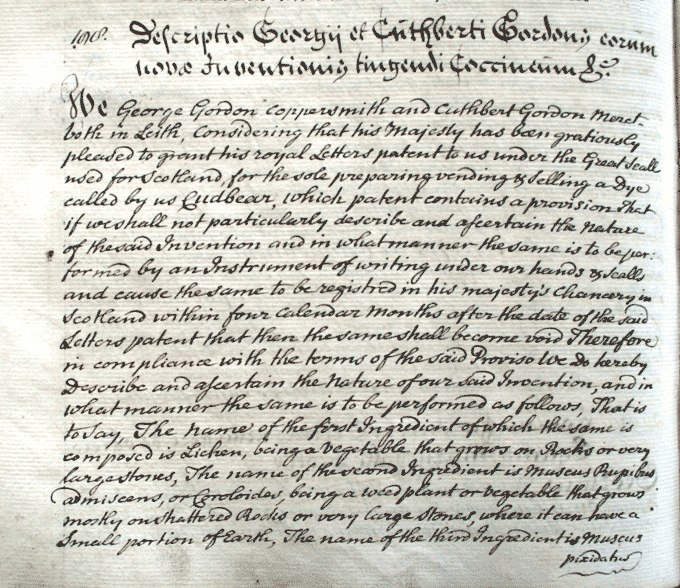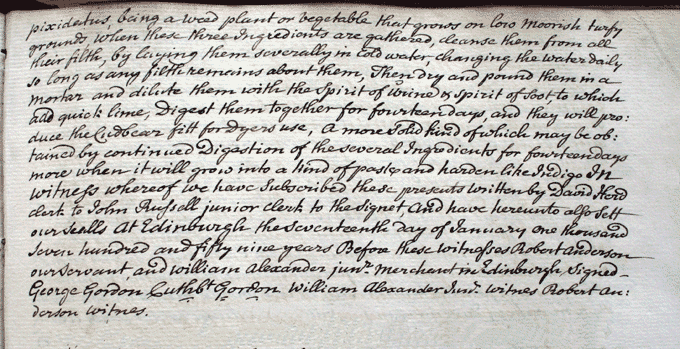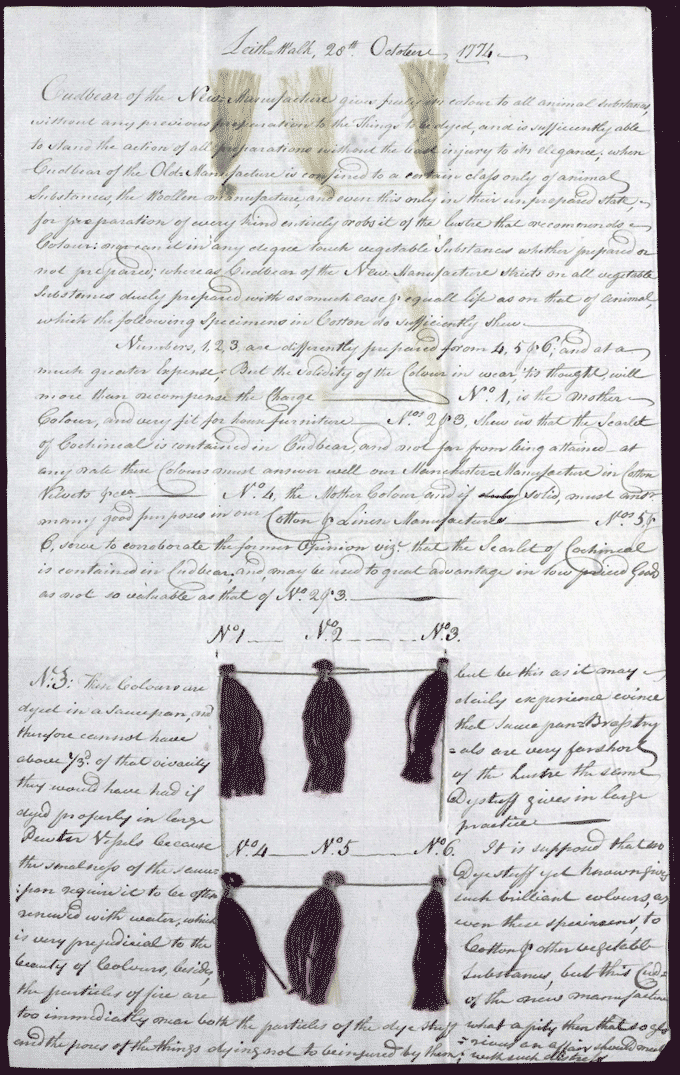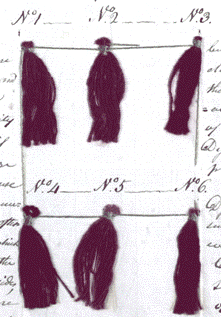The Cudbear Manufactory
Before the sixteenth century, checked and striped fabrics were mostly woven in natural and vegetable-dyed wools. Surviving Gaelic verse suggests that there was a general preference for bright rather than muted colours with bright red being a symbol of high fashion and status. From an early date, cochineal and indigo dyes were imported to Scotland so that those with sufficient wealth could wear bright coloured clothing.
The Scottish textile industry in the eighteenth and nineteenth centuries was notable for its inventiveness and creativity, with entrepreneurial Scots seeking to create a ‘home-grown’ alternative to expensive imported dyes.
George Gordon, a coppersmith, was repairing an old copper boiler in a dye house in London, when he noticed the similarities between the process used to create Archella dye with the way his grandmother used to produce dyes in the Highlands. Archella is a bright red to rich purple natural dye obtained from several lichens. It is known to have been used by the Egyptians and its preparation was rediscovered by an Italian in the Middle Ages and used to make the brilliant reds and purples in Florentine cloth.
On his return home to Leith, George Gordon shared his observations with his nephew, Cuthbert Gordon, who was a chemist. Cuthbert proceeded to perform a series of experiments which resulted in the discovery of a new method of producing a vibrant red and purple dye from readily available Scottish lichens. The product was called ‘Cudbear’, taken from the name, ‘Cuthbert’. His attempts to put it into production and to make his fortune had mixed results.
The Cudbear Patent, 1758
Attracting investment for the Cudbear manufactory, 1764
Samples of the Cudbear dye, 1774
State of Discoveries made by Mr Cuthbert Gordon and Memorial for the Discoverer, 1785
|
Source 1: The Cudbear Patent, 1758
In 1758 George and Cuthbert Gordon patented their most valuable and beneficial dye, which we call cudbear; which said dye is of the most efficacious nature in dying crimson and purple, so as in great measure to supply the use of the archelia or Spanish weed, and is entirely composed of materials the produce of Great Britain or of His Majesty’s plantations. [Letters patent for G & C Gordon’s Specification, published by G E Eyre and W Spottiswoode, 1856]. The patent was recorded in Scotland in 1759 in the Register of the Great Seal.
Page 1

Transcript and translation:
198. Description of George and Cuthbert Gordons’
new invention for dyeing scarlet etc.
We, George Gordon, coppersmith, and Cuthbert Gordon, Merc[han]t,
both in Leith, Considering that his Majesty has been gratiously
pleased to grant his royal letters patent to us under the Great Seall
used for Scotland, for the sole preparing, vending & selling a Dye
called by us Cudbear, which patent contains a provision that
if we shall not particularly describe and ascertain the nature
of the said Invention and in what manner the same is to be per-
formed by an Instrument of writing under our hands & sealls
and cause the same to be regist[e]red in his majesty’s Chancery in
Scotland within four calendar months after the date of the said
Letters patent, that then the same shall become void. Therefore,
in compliance with the terms of the said Proviso, We Do hereby
Describe and ascertain the nature of our said Invention, and in
what manner the same is to be performed as follows. That is
to say, The name of the first Ingredient of which the same is
composed is Lichen, being a vegetable that grows on Rocks or very
large stones. The name of the second Ingredient is Muscus Rupibus
admiscens, or Coroloides, being a weed plant or vegetable that grows
mostly on shattered Rocks or very large Stones, where it can have a
Small portion of Earth. The name of the third Ingredient is Muscus
Pixidatur
Glossary:
Muscus is Latin for ‘moss’ or ‘lichens’. The ingredients specified in the patent above are a mixture of Scottish lichens which are known by their Latin names: Muscus Rupibus admiscens, which can be translated as mixed rock lichens, also known as Coroloides or Cladonia, and Muscus Pixidatus which is also known as Cladonia pyxidata. In particular the lichens lecanora tartarea and ochrolechia tartarea were used in the manufacture of Cudbear. Images of some of these lichens can be found online at http://nature-diary.co.uk/species-index-fungi.htm#lichens.
Some of the common names for these lichens are crotal, crottle, corcur, korkir (Gaelic), archil and orchil (England).
Page 2

Transcription:
pixidatus, being a weed plant or vegetable that grows on low moorish turfy
grounds. When these three Ingredients are gathered, cleanse them from all
their filth, by laying them severally in cold water, changing the water daily
so long as any filth remains about them. Then dry and pound them in a
mortar and dilute them with the spirit of urine & spirit of soot, to which
add quick lime. Digest them together for fourteen days, and they will pro-
duce the Cudbear fitt for Dyers use. A more solid kind of which may be ob-
tained by continued Digestion of the several Ingredients for fourteen days
more when it will grow into a kind of paste and harden like Indigo. In
witness whereof we have subscribed these presents written by David Herd
clerk to John Russell junior clerk to the signet, and have hereunto also Sett
our sealls. At Edinburgh the seventeenth day of January one thousand
seven hundred and fifty nine years Before these witnesses: Robert Anderson,
our servant, and William Alexander jun[io]r Merchant in Edinburgh. Signed George
Gordon, Cuthbert Gordon, William Alexander jun[io]r, witnes, Robert An-
derson, witnes.
(National Records of Scotland reference: C3/19 no.198) |
Source 2: Attracting investment for the Cudbear manufactory, 1764
Cuthbert Gordon established a Cudbear Manufactory in Leith, in partnership with the Alexanders, who paid for the erection of the works and invested capital to a value of £1200 sterling for a quarter share in the company. The agreement stated that the said George and Cuthbert Gordon bind and oblige them to take the trouble of making and manufacturing the said dye, and William Alexander and his two sons bind and oblige them to take the trouble of vending the same. (Extracted from Answers for Cuthbert, James and William Gordons, partners of the Cudbear-manufactory in Leith, 2 December 1773, National Records of Scotland reference: GD44/51/763/7)
The business struggled however, with the Gordons blaming the Alexanders for failing to market the Cudbear with any real enthusiasm, and they sought additional investment from other sources. George and Cuthbert contacted estate owners and managers to demonstrate the potential of harvesting naturally occurring lichens from barren Highland estates.
The following extract comes from a memorial by George and Cuthbert Gordon, Patentees of the Cudbear Manufacture at Leith, in 1764, that sets out the potential value of the production and manufacture of Cudbear for landowners and the Scottish dye industry. It was addressed to the Hon[oura]ble Commissioners of His Majesty’s Annexed Estates in Scotland.
The Memorialists are certain that they have made Discoverys, which will enable them to improve Such Estates in the Highlands as abound with Rock, Water and Heath (that is to say almost the whole of it) so as to double the present Rent, and also to defray the Expence of the Improvement in the Space of Four years.
According to the Memorialists Computation, which they believe is very exact, the Expence of introducing this Improvement will not exceed two years rent of the Estate or Farm to be improved, whereas the profits of it may be made perpetual, and attained without any inconveniency or detriment to the present Possessors, who may go on employing their Grass & arable lands as usual.
The particulars of the Memorialists Scheme, it may be improper, for Obvious Reasons, to expose to public view till such time as it can be done without any essential prejudice to their private Interest. The Memorialists hope to be pardoned for entering into them no further than to say that the advantage proposed by their Scheme is to raise upon those Barren mountains a certain annual produce, with which the Mercate [market] cannot be overstocked and which will find sufficient vent in most parts of Europe as well as Great Britain and Ireland. In the meantime, to show the integrity of the Memorialists Intentions and their Confidence of Success, they are willing to make the Experiment at their own Expence, and, if they fail in the attempt, to be entitled to no Reward…The Memorialists offer to make the Barren Hills of their Country of equal value with its fertile Plains.
Without reducing the price of any other Commodity, and without interfering with his ordinary Occupation, the Memorialists propose to enable the Farmer with little labour and at a small expence, to profite himself and double the rent of his Landlord. If the Memorialists accomplish this, others as well as they will reap the advantages; if not, they themselves will be the only Sufferers.
To follow nature is a well known but too much neglected Rule, and the Memorialists will venture to affirm that that has been the case in several former attempts to improve the Highlands of Scotland: the Soil and Climate were little Consulted, and Rules, which Succeed so well in more Southern and warmer Countries, were unsuccessfully practised among the Cold watry [watery, wet] mountains of the Highlands; but nature herself seems to have pointed out those parts for that kind of Improvement which they offer to introduce.
(National Records of Scotland reference: E728/27/1(1)) |
Source 3: Samples of the Cudbear dye, 1774
Relations with the Alexanders continued to deteriorate until the company was dissolved in 1773. On the 4 April 1775 Cuthbert Gordon petitioned the Lords of the Council and Session for the sequestration of his personal estate and effects, and found himself imprisoned in the Canongate tolbooth as a debtor. He was freed so that he could re-develop the Cudbear manufactory in order to pay his debts and satisfy his creditors. To achieve this, Cuthbert proceeded to re-advertise and market his process.

Transcript:
Leith Walk, 28th October 1774
Cudbear of the New Manufacture gives fully its colour to all animal substances,
without any previous preparation to the things to be dyed, and is sufficiently able
to stand the action of all preparation without the least injury to its elegance; when
Cudbear of the Old Manufacture is confined to a certain class only of animal
Substances, the Woollen Manufacture, and even this only in their unprepared state –
for preparation of every kind entirely robs it of the lustre that recommends
Colour: nor can it in any degree touch vegetable Substances whether prepared or
not prepared; whereas Cudbear of the New Manufacture sticks on all vegetable
Substances duely prepared with as much ease & equall life as on that of animal,
which the following Specimens in Cotton do sufficiently show.
Numbers 1, 2, 3, are differently prepared from 4, 5 & 6; and at a
much greater Expense; But the validity of the Colour in wear, ‘tis thought, will
more than recompense the Charge. No. 1 is the Mother
Colour, and very fit for house furniture. Nos 2 & 3 show us that the Scarlet
of Cochineal is contained in Cudbear, and not far from being attained at
any rate these Colours must answer well our Manchester Manufacture in Cotton
Velvets etc. No. 4, the Mother Colour, and if solid, must ans[we]r
many good purposes in our Cotton & Linen Manufacture. Nos 5 &
6 serve to corroborate the former Opinion viz. that the Scarlet of Cochineal
is contained in Cudbear, and may be used to great advantage in low priced Goods
as not so valuable as that of No. 2 & 3.
 NB. The Colours are
NB. The Colours are
dyed in a saucepan, and
therefore cannot have
above 1/3d of the vivacity
they would have had if
dyed properly in large
Pewter Vessels because
the smallness of the sauce-
pan require it to be often
renewed with water, which
is very prejudicial to the
beauty of Colours, besides,
the particles of fire are
too immediately near both to the particles of the dye stuff
and the pores of the things dying not to be injured by them;
but be this as it may
daily experience evince
that saucepan Brass try-
als are very far short
of the Lustre the same
Dyestuff gives in large
practice.
It is supposed that no
Dyestuff yet known gives
such brilliant colours, as
even these specimens, to
Cotton & other vegetable
substances, but this Cud[bear]
of the new manufacture.
What a pity then that so glo-
rious an affair should meet
with such distress.
This document is reproduced by kind permission of His Grace the Duke of Richmond and Gordon.
(National Records of Scotland reference: GD44/43/137/41)
|
Source 4: State of Discoveries made by Mr Cuthbert Gordon and Memorial for the Discoverer, 1785
In this memorial Cuthbert Gordon traces the history of Cudbear from his initial experiments through to the establishment and failure of his manufactory. In 1776 George Macintosh of Dunchattan invested in the Cudbear business with Cuthbert Gordon. The works were moved from Leith to Dunchattan House, near Craig's Park in Glasgow and, whilst Cuthbert Gordon managed the practical manufacturing, Mr Macintosh managed the business. The Glasgow works of George Macintosh & Co remained in business until 1852.
Mr Gordon, from natural appearances upon a vegetable substance plentifully produced in the Grampian Hills [These hills run from East to West, and divide the North of Scotland], was led to think that a dying or colouring ware might thence be obtained.
After many experiments, and much application, Mr Gordon had the pleasure of producing a dye ware, which answered all the purposes to which archel [A dying ware, the materials of which have been usually imported from the Canary and Cape de Verde Islands etc] was applied.
Further trials evinced that the new material might be, in a certain degree, substituted for indigo and cochineal. The proportions were soon ascertained with precision; the new article saved one third of indigo in striking the various shades of blue and purple on silk and wool; and one fourth of cochineal in every case where that high-priced article was necessary, scarlets and high pinks excepted.
To this new invented dye Mr Gordon gave the appellation of Cudbear from his own Christian name.
In such cases, it is not enough to produce an article of commerce. It behoves the inventor to establish it, not only against the prejudices which a great number of mankind entertain to novelty; but what is still more difficult, against the interested views of the traders in those articles, the consumption of which is proposed to be diminished, or superceded by the new discovery.
Mr Gordon maintained a long and obstinate struggle of this kind, and only succeeded at last by submitting to the extraordinary toil of personally instructing the dyers and manufacturers in the use of the Cudbear.
This done, a company for manufacturing that article was established at Leith; the partners were Mr Gordon and his brother; supported by a considerable mercantile house in the neighbouring city of Edinburgh.
The failure of that house, in consequence of other connections, brought on the dissolution of the company, and all the bad consequences attending a sudden and unexpected stop in an infant manufacture.
The merit, however, of the Cudbear had been, by this time, so far established, that a new company was soon afterwards formed in Glasgow.
The prejudices of the practical dyers gave way by degrees; the new article came into more general use and estimation; in consequence of which the importation of archel has decreased almost to a trifle; and the importation of the articles of indigo and cochineal has likewise diminished, and will continue to diminish in the proportions before mentioned.
The Glasgow company have been followed by several others, and at this moment the manufacture is carried on in London, Bristol, Manchester, Leeds, and in Leith.
Mr Gordon, however, has not escaped the misfortune usually attendant on inventors in the arts.
The extraordinary expences incurred in the maufacture and improvement of the Cudbear, as well as the struggle for establishing it, occasioned the contraction of considerable debts, to discharge which he was obliged to sell out his share in the Glasgow company.
The peculiarity of Mr Gordon’s situation, in being excluded from the advantages of a manufacture established by himself, would have been distressing, had it not been alleviated by the hopes of new and more important discoveries in the art of dying.
The introduction of Cudbear had already established the dyes of blue, purple and crimson, to be used on wool, silk, and other animal materials that might answer on the manufactures of cotton and linen.
His study and application were at last so far rewarded, by discovering that the vegetable filament, by a proper treatment, may be impressed with all the variety of colours, equal in lustre, and with the same ease and safety to the subject, as wool, silk or other animal substance.
This capital fact being established in two or three instances, reasonable grounds were then given to suppose, that every individual plant was, by a suitable process, capable of producing one or other of the original colours of light, or a variety, or shade of that colour peculiar to itself.
Every successive experiment afforded an additional proof, and determined Mr Gordon to dedicate his whole time, and the remainder of his fortune, to an investigation of the powers of the common indigenous plants in the production of colours.
Mr Gordon selected one species out of each genus marked by Tournefort [The arrangement of this author proved sufficient for regulating the enquiry. No predilection for his system is intended to be marked by this circumstance], to the number of ninety, and in making this choice, he was principally directed by the circumstance by the plants being common in our own fields and forests, or capable of easy cultivation in the climate of Great Britain.
The investigation, after all, has gone no further than one to ninety, even according to Tournefort. Five books, however, are filled up by it, each book consisting of one hundred and seventy-six specimens of beautiful and elegant dyes, struck upon cotton and linen.
To exhibit the primary colours by themselves, Mr Gordon has displayed and arranged them in a sixth book, which may be considered as the summary, or substance of the preceding five.
These specimens are attended with distinct catalogues of the plants, from which they were produced.
Having proceeded so far, Mr Gordon found that he could not, in justice to himself or his undertaking, go on without aid from the public. He has done more than enough to establish the principle of his discovery, and to substantiate the improvements which must necessarily be derived to the manufactures of this kingdom.
Should the use of the article of madder [the common name for the dye plant Rubia tinctorum] alone be superceded by the spontaneous, and at present useless productions of our own country, the saving must of itself be of capital importance. For that dying ware, Holland draws some hundred thousand pounds annually from Great Britain.
Mr Gordon has not brought forward his discoveries to the public in the first instance. They have been submitted to the examination of the principal merchants, manufacturers, and dyers; and he has the great satisfaction of annexing to this paper certificates in their favour from Leeds, Wakefield, Hallifax, Rochdale, Edinburgh, Glasgow and Paisley.
It is not long since parliament condescended to bestow ample rewards for the production of single colours only. One gentleman obtained three thousand pounds for a yellow; and another a much larger sum for a colour in imitation of scarlet.
Mr Gordon, without meaning or wishing to detract from the merits of these ingenious men, appeals to the manufacturers of Great Britain, whether the discovery of the Cudbear alone, be not already of more importance to the nation, than either or both of the articles last mentioned.
In place of a single colour, he is now ready to exhibit to the public the whole original colours, and all their variety of shades, without the aid of an article from foreign parts; and he humbly apprehends, that no discovery whatever can tend so much to place the manufactures of Great Britain beyond the powers of rivalship.
It is Mr Gordon’s great object to bring forward his last discoveries into practice, and to see them established during his own life time. He is also most desirous to extend his enquiries, by a proper investigation of as many of the untried vegetable productions as his time shall permit.
For these purposes he thinks himself entitled humbly to request the aid of Parliament.
Cuthbert Gordon
Extracted from Memorial of Mr Cuthbert Gordon relative to the Discovery and Use of Cudbear, and other Dying Wares, printed, 1785.
(National Records of Scotland reference: GD113/1/487)
Back to top
|